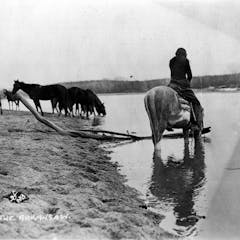
Articles on Native Americans
Displaying 1 - 20 of 186 articles

A historian of astronomy writes about the role of astronomical events in Indigenous cultures − and also the exploitation of their sacred traditions in present times.

The monument’s ancient connection to the skies may run even deeper than we realised.

The Federal Energy Regulatory Commission recently ruled that it won’t approve energy projects on Native lands without tribal consent. But many more applications are pending.

U.S. laws on the repatriation of Indigenous artifacts and remains still uphold inequities in the relationships between Indigenous people and the agencies holding their materials.

Gladstone has used her platform in the run-up to this year’s awards season to highlight issues affecting Native American communities in America today.

Dogs have lived with Indigenous Americans since before they came to the continent together 10,000 years ago. A new analysis reveals the lineage of one 1800s ‘woolly dog’ from the Pacific Northwest.

Native American families have endured generations of systematic child removal, but the grief, loss and trauma that birth mothers still experience have been largely overlooked.

Rather than have students memorize names and dates, this history curriculum invites students to grapple with real-life issues faced by people from the past.

A scholar of Native American and Indigenous rhetorics writes about the harm done to Native American nations through colonization and what can be done to reduce it.

The origins of the Indigenous People’s Thanksgiving Sunrise Ceremony, held on the traditional lands of the Ohlone people, go back to 1969, a pivotal moment of Indigenous activism.

Cranberries add color and acidity to Thanksgiving menus, but they also have many interesting botanical and genetic features.

Despite the perpetrators being tried and convicted, anti-Indigenous sentiment roiled the area for decades.

The Osage murders of the 1920s are just one episode in nearly two centuries of stealing land and resources from Native Americans. Much of this theft was guided and sanctioned by federal law.

Efforts are being made to develop the capacity of Native tribes to manage bison and bison habitats. An Indigenous scholar explains their sacred significance.

Popular culture often describes scalping − the forceful removing of a person’s scalp − as an indigenous practice. But white settlers accelerated this form of violence against Native Americans.

An Indigenous sacred site, Hopewell Ceremonial Earthworks has served as a military barracks, a fairground and, more recently, a golf course.

A pipeline that has carried Canadian oil and gas across Wisconsin and Michigan for 70 years has become a symbol of fossil fuel politics and a test of local regulatory power.

The largest dam removal project is moving forward on the Klamath River in California and Oregon. Tribal nations there have fought for decades to protect native fish runs and the ecology of the river.

By a narrow margin, the Supreme Court has ruled against the Navajo Nation in a case over water rights in the drought-stricken US Southwest.

A Supreme Court ruling has upheld the right of Congress to pass laws about Native American tribes’ rights to self-government.





